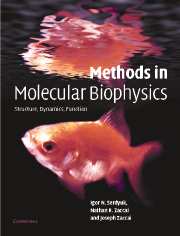Book contents
- Frontmatter
- Contents
- Foreword by D. M. Engelman
- Foreword by Pierre Joliot
- Preface
- Introduction: Molecular biophysics at the beginning of the twenty-first century: from ensemble measurements to single-molecule detection
- Part A Biological macromolecules and physical tools
- Part B Mass spectrometry
- Part C Thermodynamics
- Part D Hydrodynamics
- Part E Optical spectroscopy
- Part F Optical microscopy
- Part G X-ray and neutron diffraction
- Chapter G1 The macromolecule as a radiation scattering particle
- Chapter G2 Small-angle scattering
- Chapter G3 X-ray and neutron macromolecular crystallography
- Part H Electron diffraction
- Part I Molecular dynamics
- Part J Nuclear magnetic resonance
- References
- Index of eminent scientists
- Subject Index
- References
Chapter G3 - X-ray and neutron macromolecular crystallography
from Part G - X-ray and neutron diffraction
Published online by Cambridge University Press: 05 November 2012
- Frontmatter
- Contents
- Foreword by D. M. Engelman
- Foreword by Pierre Joliot
- Preface
- Introduction: Molecular biophysics at the beginning of the twenty-first century: from ensemble measurements to single-molecule detection
- Part A Biological macromolecules and physical tools
- Part B Mass spectrometry
- Part C Thermodynamics
- Part D Hydrodynamics
- Part E Optical spectroscopy
- Part F Optical microscopy
- Part G X-ray and neutron diffraction
- Chapter G1 The macromolecule as a radiation scattering particle
- Chapter G2 Small-angle scattering
- Chapter G3 X-ray and neutron macromolecular crystallography
- Part H Electron diffraction
- Part I Molecular dynamics
- Part J Nuclear magnetic resonance
- References
- Index of eminent scientists
- Subject Index
- References
Summary
Historical review
The discoveries of X-rays, electrons and neutrons as major achievements in the field of biological crystallography have been honoured by Nobel prizes in physics, chemistry and physiology or medicine, spread over the more than 100 years since their inception in 1901.
The very first Nobel prize in physics was awarded to W. C. Röntgen ‘in recognition of the extraordinary services he has rendered by the discovery of the remarkable rays subsequently named after him’. J. J. Thomson obtained the Nobel physics prize in 1906 ‘in recognition of the great merits of his theoretical and experimental investigations on the conduction of electricity by gases’. M. von Laue was awarded the physics prize in 1914 ‘for his discovery of the diffraction of X-rays by crystals’, and W. H. Bragg and W. L. Bragg, in 1915, ‘for their services in the analysis of crystal structure by means of X-rays’. J. Chadwick was awarded the Nobel prize in physics in 1935 ‘for the discovery of the neutron’.
The birth of molecular biology was honoured appropriately with the award of the 1962 Nobel prize in physiology or medicine to J. Watson, M. Wilkins and F. Crick ‘for their discoveries concerning the molecular structure of nucleic acids and its significance for information transfer in living material’, and, in the same year, the award of the chemistry prize to M. F. Perutz and J. C. Kendrew ‘for their studies of the structures of globular proteins’.
- Type
- Chapter
- Information
- Methods in Molecular BiophysicsStructure, Dynamics, Function, pp. 838 - 882Publisher: Cambridge University PressPrint publication year: 2007



